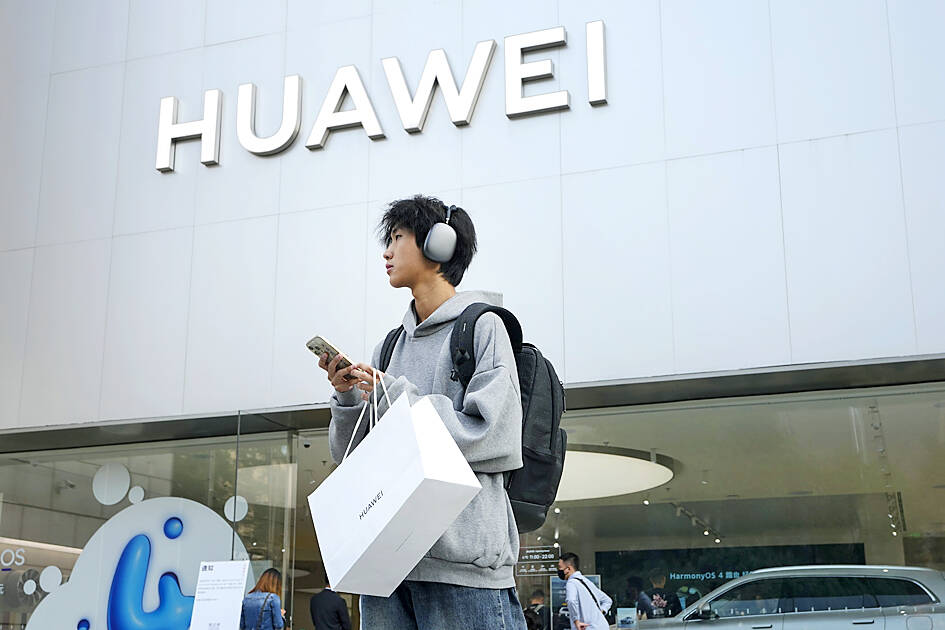Huawei Technologies Co’s (華為) newest laptop runs on a chip made by Taiwan Semiconductor Manufacturing Co (TSMC, 台積電), a teardown of the device showed, quashing talk of another Chinese technological breakthrough.
The Qingyun L540 notebook contains a 5-nanometer chip made by the Taiwanese company in 2020, about the time US sanctions cut off Huawei’s access to the chipmaker, research firm TechInsights found after dismantling the device for Bloomberg News.
That counters speculation that Huawei’s domestic chipmaking partner, Semiconductor Manufacturing International Corp (SMIC, 中芯), might have achieved a major leap in fabrication technique.

Photo: AP
Huawei caused a stir in the US and China in August when it released a smartphone with a 7-nanometer processor made by Shanghai-based SMIC.
A teardown by the Canada-based research outfit for Bloomberg News showed the Mate 60 Pro’s chip was only a few years behind the cutting edge, a feat that US trade curbs were meant to prevent. That revelation spurred celebration across the Chinese tech scene, and a debate in the US about the effectiveness of sanctions.
In the latest teardown, TechInsights discovered a Kirin 9006C processor fabricated via TSMC’s 5-nanometer method, which was assembled and packaged in late 2020.
Industry experts had previously speculated that SMIC achieved that milestone by developing workarounds to US sanctions, which would have marked a second technological triumph for the Chinese national champion in just a few months.
The advances encapsulated in the Mate 60 smartphone last year cemented Huawei’s role as the standard-bearer for Chinese efforts to wean itself off Western technologies and create domestic alternatives.
Chinese consumers snapped up the smartphone in the final quarter, helping the company regain the symbolically important US$100 billion revenue threshold — eroding Apple Inc’s iPhone dominance along the way.
A foray into 5-nanometer territory would have represented a big leap for the Shenzhen conglomerate, bringing it closer to the most advanced processes currently in use, mostly centered at about 3-nanometer nodes. Before TSMC cut off ties with Huawei, it was supplying chips as advanced as 5-nanometers to the Chinese firm.

IN THE AIR: While most companies said they were committed to North American operations, some added that production and costs would depend on the outcome of a US trade probe Leading local contract electronics makers Wistron Corp (緯創), Quanta Computer Inc (廣達), Inventec Corp (英業達) and Compal Electronics Inc (仁寶) are to maintain their North American expansion plans, despite Washington’s 20 percent tariff on Taiwanese goods. Wistron said it has long maintained a presence in the US, while distributing production across Taiwan, North America, Southeast Asia and Europe. The company is in talks with customers to align capacity with their site preferences, a company official told the Taipei Times by telephone on Friday. The company is still in talks with clients over who would bear the tariff costs, with the outcome pending further

A proposed 100 percent tariff on chip imports announced by US President Donald Trump could shift more of Taiwan’s semiconductor production overseas, a Taiwan Institute of Economic Research (TIER) researcher said yesterday. Trump’s tariff policy will accelerate the global semiconductor industry’s pace to establish roots in the US, leading to higher supply chain costs and ultimately raising prices of consumer electronics and creating uncertainty for future market demand, Arisa Liu (劉佩真) at the institute’s Taiwan Industry Economics Database said in a telephone interview. Trump’s move signals his intention to "restore the glory of the US semiconductor industry," Liu noted, saying that

NEGOTIATIONS: Semiconductors play an outsized role in Taiwan’s industrial and economic development and are a major driver of the Taiwan-US trade imbalance With US President Donald Trump threatening to impose tariffs on semiconductors, Taiwan is expected to face a significant challenge, as information and communications technology (ICT) products account for more than 70 percent of its exports to the US, Chung-Hua Institution for Economic Research (CIER, 中華經濟研究院) president Lien Hsien-ming (連賢明) said on Friday. Compared with other countries, semiconductors play a disproportionately large role in Taiwan’s industrial and economic development, Lien said. As the sixth-largest contributor to the US trade deficit, Taiwan recorded a US$73.9 billion trade surplus with the US last year — up from US$47.8 billion in 2023 — driven by strong

STILL UNCLEAR: Several aspects of the policy still need to be clarified, such as whether the exemptions would expand to related products, PwC Taiwan warned The TAIEX surged yesterday, led by gains in Taiwan Semiconductor Manufacturing Co (TSMC, 台積電), after US President Donald Trump announced a sweeping 100 percent tariff on imported semiconductors — while exempting companies operating or building plants in the US, which includes TSMC. The benchmark index jumped 556.41 points, or 2.37 percent, to close at 24,003.77, breaching the 24,000-point level and hitting its highest close this year, Taiwan Stock Exchange (TWSE) data showed. TSMC rose NT$55, or 4.89 percent, to close at a record NT$1,180, as the company is already investing heavily in a multibillion-dollar plant in Arizona that led investors to assume